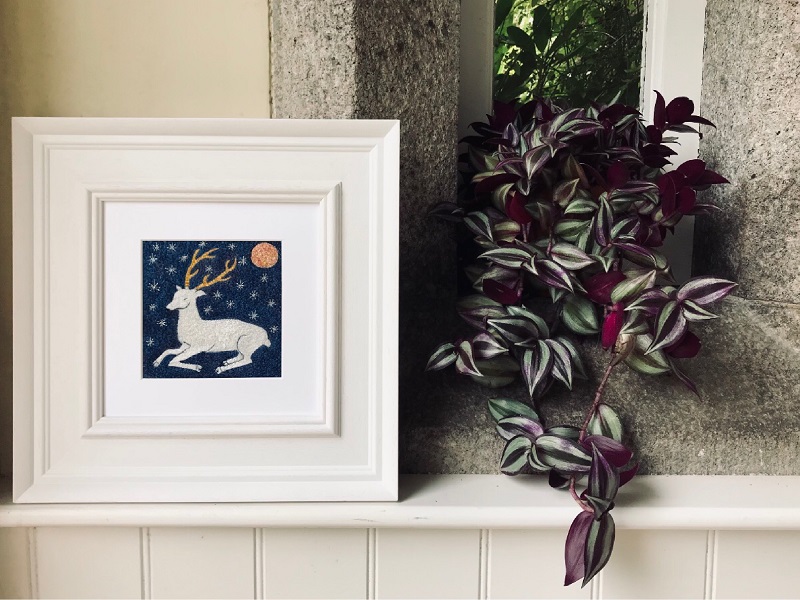Welcome to our Make Your Own Story feature, a series of interviews with makers where we delve into inspiring stories about living and working in Scotland.
Moira Third is an artist and maker, who works from her attic studio in Glenmuick in Scotland’s Cairngorms National Park. She explores the landscape, folktales and songs of the North in her work, which includes embroidered wall mounted and 3D artworks that are minimal and serene. Moira lost her hearing after a viral infection a few years ago and in response to this, tries to convey a sense of silence in every piece that she makes.
Hello Moira. could you tell us a little bit about your practice and what inspired you to work with textiles?
I have always worked with textiles, beginning with a small production knitwear company in the 1980s, which led me to hand spinning and natural dying, using my yarns to create needlepoint. I dabbled in tapestry weaving but when I first encountered Phoebe Anna Traquair’s embroidered panels in The Progress of a Soul at the Scottish National Gallery in Edinburgh, it firmly placed me on the path of my current journey. I was totally seduced by the colour and luminosity of thread, the way light would play on the surface creating endless nuances of light and shade, I knew it to be my medium of choice.
It wasn’t until I stumbled across an article about Alice Kettle in a Country Living Magazine in the mid 1990s that I could see a way forward, using the needle of my sewing machine, guided by hand, to apply layers of thread whilst building colour, texture and meaning. It took a lot of blood, sweat and broken needles to become proficient but I have never looked back!
I only ever use straight stitch; I feel that its simplicity is concealed by the sheer volume of stitching. I paint every canvas before beginning to stitch – some may find this strange, but for me, it’s akin to the layers of light we experience between day and night, the seen and the unseen, the familiar and the secret. I also like the idea of something hidden; very often what we see under paintings is quite different from what we see on the surface. You can never be 100% sure what lies concealed beneath the thread in my work!
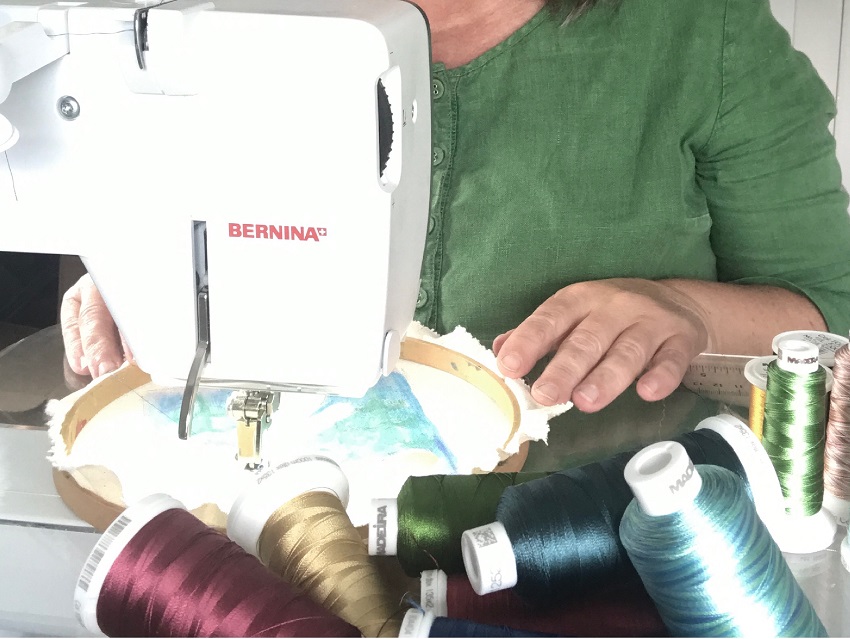
Image: Moira Third/ Photography by the artist
Tell us about your time at Gray’s School of Art?
Gray’s School of Art in Aberdeen was such a joyous place for me, filled with enthusiastic tutors and a fantastic library to boot. I chose not to study textiles, although I have to say the department was always very appealing, I knew at that point that my interest lay in the fine art department. I had been painting and stitching canvas for a few years with a couple of exhibitions behind me and it was conceptual development that I craved. I studied contemporary sculpture as an undergraduate and enjoyed every moment of my time there, so much so that after my Honours year I stayed on to study on the Masters course.
I frequently returned to the use of textile techniques and experimented with, amongst other things, latex moulded garments, feather and wool-covered trees not to mention miles of stitched text and soundwaves! There were endless opportunities to investigate methods and materials within the department, and ideas and outcomes were fully explored and critiqued.
You mention you are influenced by natural beauty, wildlife and the landscape. How does this manifest itself in your creative process?
I am fortunate to live in an area of outstanding beauty. Wild and remote, the changing seasons are much more apparent here, with geese and migratory birds a transient reminder. A walk up the Glen reveals a landscape to rival a Sir Edwin Landseer painting; furnished with stags, waterfalls, heather moorland, snow-capped mountains and a dramatic loch. Whilst the gentler birch woodlands around my house, and the river which tumbles its way along the bottom of my garden - is a sanctuary for flora and fauna and an invitation to daydream.
I spend time outdoors, becoming part of this picture as often as I can, but I am aware that it is the human perception of this landscape that interests me most. We still have an irrational fear of the wilderness and more so after dark. When night falls here in the wild, there are no streetlights to illuminate, and moonlight serves to transform the known. Things become shapes and forms, familiar and yet unfamiliar. My stripped back imagery embraces the dreamlike; landscape, animals, birds, objects – not facsimiles of the real thing but a shadow form, devoid of detail, recognisable but changed.
It would be wrong though to suggest that this is my only influence, I love to read and often the images or emotions conjured up by a line in a novel or poem will strike a chord and act as a starting point for new work.
The influence and aesthetics of the late artist and printmaker Craigie Aitchison is, I feel, consistently visible in my work; a distillation and repetition of the subject, placed in a spartan landscape brought to life by luminous colour.
Can you explain what the white hare that is present in your work represents?
The white hare is very special to me and I’m often asked about its significance in my work. When I lost my hearing after a viral infection, I struggled to cope with the changes it forced upon me. A close encounter with a winter coated mountain hare during a terrible snowstorm going over Glenshee, reminded me that change was a natural thing, and that transformation was critical to adapting in order to survive.
So the white hare, for me, has become an analogy for transformation, adaptability, change and something which is comfortable in its changing environment.
Other animals and birds have made it onto the canvas now too, and they all come with their own symbolic references, not to mention objects, in particular chairs and vases all loaded with meaning and associations.
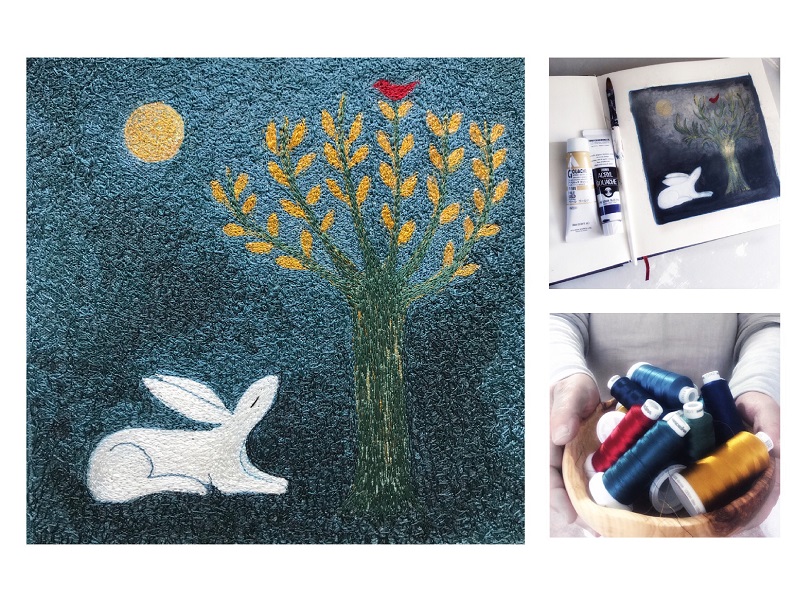
Image: Moira Third/ Photography by the artist
Can you tell us about any recent projects or commissions you have been working on?
I recently worked on new pieces for the winter exhibitions in the galleries who exhibit my work. Towards the end of 2021, I also had a space at Flock at The Barn, Banchory, an annual curated selling event.
As each piece I make is an original. The amount of work I can produce is limited and I only ever work on one piece at a time, giving each one my whole attention from conception to finishing. This reminds me that I am a maker, not a manufacturer, and has a satisfyingly wholesome effect on my output.
I will also be revealing some new chair pieces very soon. The chair is something I started to stitch many years ago and produced several large pieces for various exhibitions. I use the image of a chair as a metaphor for human presence, as infinitely variable as ourselves and yet a wholly human construct.
What do you hope that audiences will take away from your work?
I hope that the viewer will experience the liminal mood and dreamlike imagery of the work. I would like them to be aware of the inherent stillness, and to take time to contemplate the poetry that the image creates through its simplicity and use of colour. Of course, my wish is for them to apply their own possible meanings and emotions to what they see.
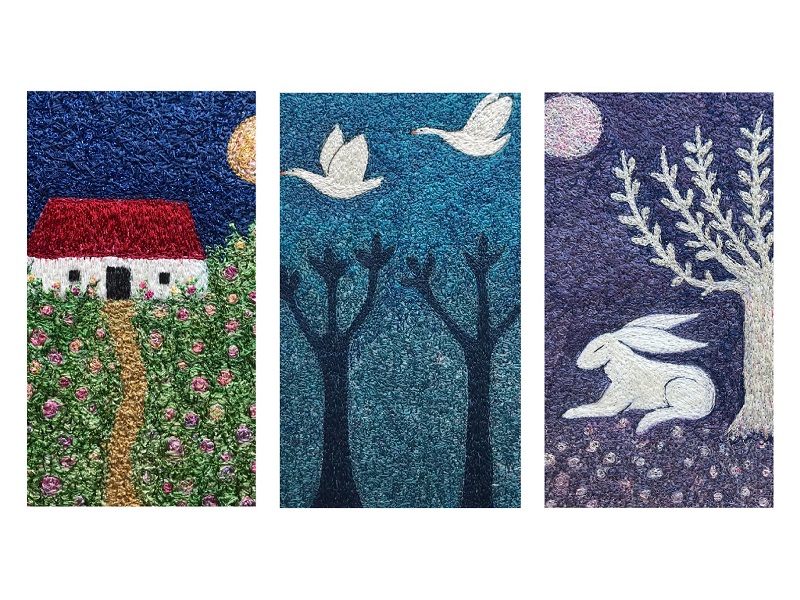
Image: Moira Third/ Photography by the artist
What’s next for your practice?
Like most other practitioners, the last year has given me time to ponder both my environmental impact and the future of my practice. I did reach some difficult conclusions as to what direction is best for me to take. I hope to increase my online presence and share more of why as opposed to how my work is made, but I also love making for galleries and exhibitions, and I hope the opportunity to make larger pieces will present itself in the near future. My main goal right now though is to keep enjoying the journey.
More about the maker: For more information on Moira Third and her work, please visit her Craft Directory profile, Facebook, Instagram and website.
 Arusa Qureshi is an award-winning writer, editor and speaker with a passion for music, diversity and accessibility within arts and culture. She has written a book about women in UK hip hop called Flip the Script, which is out now via 404 Ink. Her bylines include the Guardian, NME, Clash, Time Out, The Forty-Five and the Scotsman, and she is part of the We Are Here Scotland team, supporting and amplifying the voices of creatives of colour in Scotland.
Arusa Qureshi is an award-winning writer, editor and speaker with a passion for music, diversity and accessibility within arts and culture. She has written a book about women in UK hip hop called Flip the Script, which is out now via 404 Ink. Her bylines include the Guardian, NME, Clash, Time Out, The Forty-Five and the Scotsman, and she is part of the We Are Here Scotland team, supporting and amplifying the voices of creatives of colour in Scotland.
She recently worked as a Researcher on the new BBC Scotland podcast Word Up!, and as a Commissioning Editor for Bella Caledonia, and was formerly Editor of The List, the UK events and entertainment publication based in Edinburgh, Scotland.
Arusa Qureshi / Photographer unknown
Read More
-
Full details→
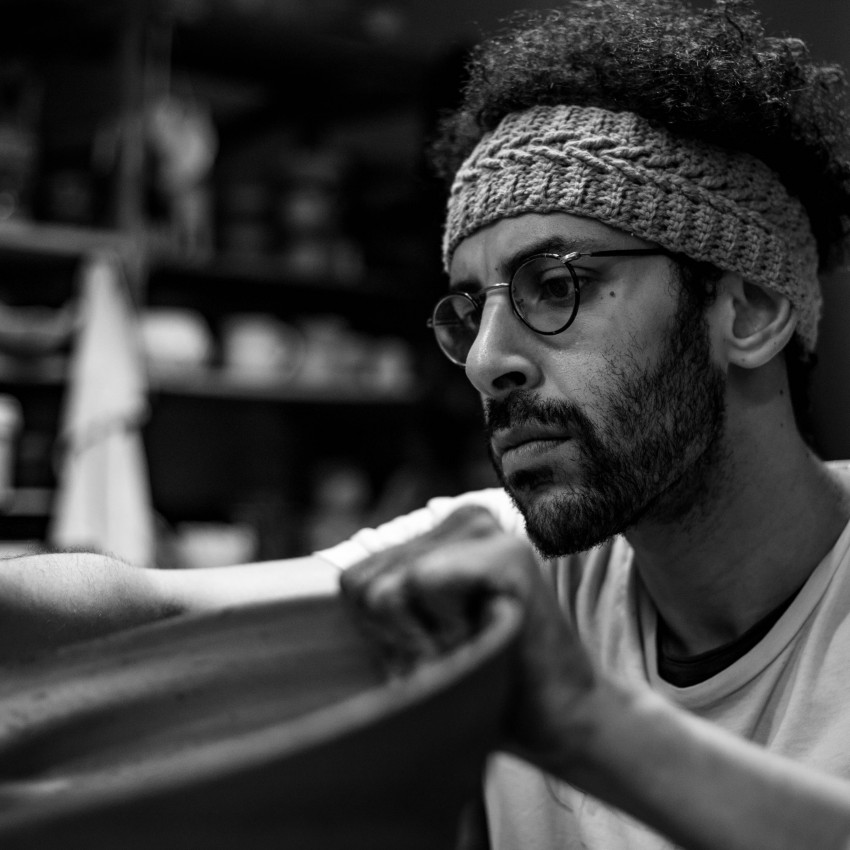
Make Your Own Story Mohamed Tonsy: Connecting Ceramics and Literature through Imagined Futures
In the latest Make Your Own Story, ceramicist Mohamed Tonsy tells us about his uses of literature and ceramics to filter his own biographical history and explore imagined near futures.
25 Nov 2021
-
Full details→
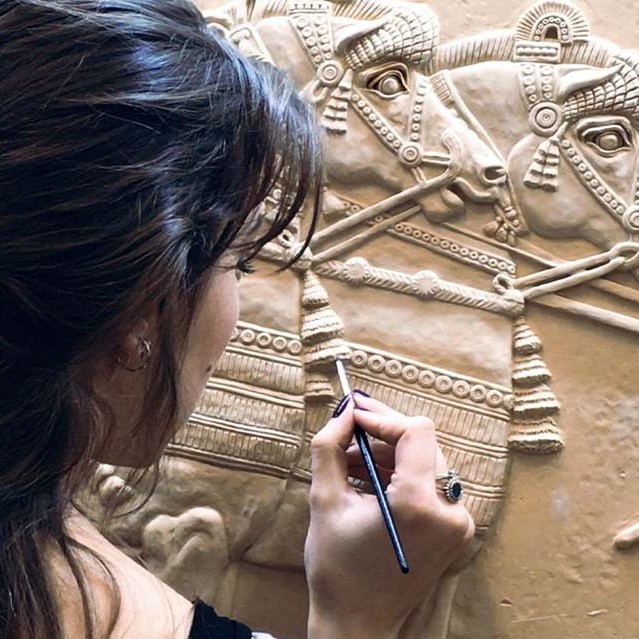
Make It Green Kate Ive: Sculpting and Carving on a Monumental and Minute Scale
In our latest Make It Green interview, award-winning Edinburgh-based artist Kate Ive tells us about creating impactful sculptural works to address the climate crisis.
11 Nov 2021
-
Full details→
![Mohamed Tonsy: Connecting Ceramics and Literature through Imagined Futures]()
Make Your Own Story Mohamed Tonsy: Connecting Ceramics and Literature through Imagined Futures
In the latest Make Your Own Story, ceramicist Mohamed Tonsy tells us about his uses of literature and ceramics to filter his own biographical history and explore imagined near futures.
25 Nov 2021
-
Full details→
![Kate Ive: Sculpting and Carving on a Monumental and Minute Scale]()
Make It Green Kate Ive: Sculpting and Carving on a Monumental and Minute Scale
In our latest Make It Green interview, award-winning Edinburgh-based artist Kate Ive tells us about creating impactful sculptural works to address the climate crisis.
11 Nov 2021
